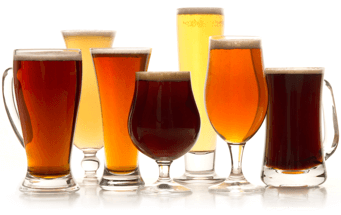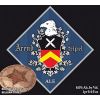Brouwerij De Ryck - Arend Tripel
-
ABV:
8.0%
In Belgium, people kept telling me about the De Ryck brewery, and mentioning that it was run by a young woman much admired for her dedication. Often, they were vague about the precise location of the brewery, and its style of beer, and I never saw the products on sale. I got there in the end, with the help of beer-lover Jeff Van den Steen, a math teacher and socialist councillor, and his wife Genevieve.
We went to the 1,000-year-old village and barony of Herzele, in endive-growing country near the hop town of Aalst. The village is between Ghent, Oudenaarde
and Brussels, 20 or 25 miles from any of them. On the main road through Herzele is the parish church, a 12th-century castle keep, a cafe called Torenhof
(named after the tower), which sells the De Ryck beer and, opposite, the wooden arch that is the entrance to the brewery.
The beer is sold in 70 or 80 cafes, but all within 15 miles.
Great Grandfather Gustave started a farm brewery on the site in 1886, and the original buildings still stand, with additions made in the 1930s and 40s.
Through the arch a cobbled yard reveals a chunky, two storey brick building, with a tall chimney.
From the earliest days, the family have done their brewing studies in Germany as well as Belgium. Great Grandfather Gustave did his pupilage at a long-gone Aitbier brewery in Bremen, called Zum Goldenen Adler (“The Golden Eagle”), and this inspired the family for a time to sub-title their own establishment De Gouden Arend or L’Aigle d’Or, depending upon your preference for language.
The De Rycks have continued to take a very German attitude toward the proper ingredients for beer. An advertisement from before the First World War announces that the beer is made from “pure malt and hops,” and even today the brewery disdains sugar - a raw material that is part of the Belgian tradition.
Paul De Ryck, father of Anne, ... studied not only at the famous Spaten brewery in Munich, but also under blue star in Newcastle. He used to discourage his daughter from hanging round the family brewery. “It’s no place for you,” he told her, perhaps shrewdly. “Children always want to do what is not allowed,” laughs Anne. “They couldn’t keep me away.” Anne went on to work in several small breweries in Bavaria, and studied as a brewing engineer in Ghent.
Her father installed a malt silo, and an auger to move the grain to the 1930s mill, so that she would not have to heft 160 pound sacks. It takes 1,800 pounds to fill the mash tun. He also fitted a mash mixing machine, to save her stirring by hand. The mash tun,... has a copper top, with counterweights to balance the lid as it is lifted.
Anne has been known to shovel out the spent grain, though she usually leaves that to a male brewery worker. The entire staff numbers seven, of which five are family members.
The kettle is copper-heated by gas, by direct flame, which Anne feels contributes to the malty character of the beer. As opposed to steam, direct flame creates “hot spots” under the kettle, and these can impart a touch of caramelisation.
The brew length is 60 hectolitres, and the kettle is fired twice a week. “So you brew one day and clean the next?” I asked. “No! As soon as we finish
brewing, we clean. Brew-and-clean, brew-and-clean.” I don’t know why I asked the question in the first place. I have never seen a brewery of this vintage
so spotless.
Three malts are used, and the brewery has water from its own wells. The kettle hops are Belgian-grown Saaz and Hallertau, as blossoms. Belgian Northern
Brewers are added in the hop back.
The Belgian hops are all grown in Aalst, though supplies are becoming less secure as farming there shrinks. Anne uses only one “foreign” hop: Styrian
Goldings in the conditioning tank.
A top-fermenting ale yeast is employed, from the oddly-named Chateau d’Eau brewery, which closed 20 years ago. Like today’s Cuvee d’Hermitage brewery, it
was in Jumet, near Charleroi.
The beers have a slow fermentation and at least four weeks’ warm conditioning. They are filtered, but not pasteurised.
Of all the ingredients, it is the malt that imposes its character most firmly on the De Ryck beers, despite the sophisticated hop regime.
On one side of the brewery yard, window boxes and pot plants announce a small shop selling the beer. For special occasions, the bottles are packed in cellophane-wrapped baskets, as though they were bouquets of flowers.
Next to the shop is the family home of Anne, her husband Omer, their 10 year-old daughter and son aged seven. Behind the yard is a sizable vegetable garden.
“You can never leave a brewery all alone. You must always watch and listen,” says Anne. “Especially in a small, old brewery like this. You have to live on
the premises. It is the only way.
“We work long hours, but that is our decision. It’s up to us. It’s our life.
“My great-grandfather had a brother, and they each needed their own activity in order to survive financially. He established the brewery, and his brother worked in leather.
“In my case, I realised that all of our family could not be supported by the brewery. My father and uncle still work in the brewery, and are co-owners, but my husband has his own business, as a pharmacist.” I cannot imagine such pure, clean beers giving anyone a headache, but they are dangerously drinkable.
Should such a misfortune occur, aspirin is at hand - the pharmacy is next door, in the brewery’s former stables.
The above was excerpted from the original published in print August 1993 in What’s Brewing

Unmatched Variety by style, brewery & country
Choose from Five different Beer Clubs offering unmatched variety by brewery,
country of origin, and beer style to suit your specific tastes.


